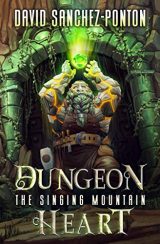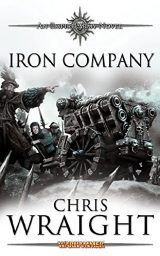This week, we take a look at Dungeon Heart, by David Sanchez-Ponton, Is it Wrong to Try to Pick Up Girls in a Dungeon #15, by Fujino Omori, and Iron Company, by Chris Wraight.
 Upon his death, the great dwarven craftsman known as The Emperor of the Forge was not returned to the halls of his ancestors. Instead, he found his essence fused to a dungeon core and hidden underground. Now known as Smit, the newborn dungeon must grow and survive. But a new dungeon brings new opportunities, and a cloud of intrigues gather outside Smit’s gate. The dungeon is unware of these threat as he focuses on something no dungeon has done before: making living art worthy of a master craftsman out of his halls.
Upon his death, the great dwarven craftsman known as The Emperor of the Forge was not returned to the halls of his ancestors. Instead, he found his essence fused to a dungeon core and hidden underground. Now known as Smit, the newborn dungeon must grow and survive. But a new dungeon brings new opportunities, and a cloud of intrigues gather outside Smit’s gate. The dungeon is unware of these threat as he focuses on something no dungeon has done before: making living art worthy of a master craftsman out of his halls.
Dungeon builder fantasy and progression fantasy follow a set pattern, and while many dungeon builders excel at developing parts of the pattern, few manage the whole. Dungeon Heart, unfortunately, is one of the former. Sanchez-Ponton wonderfully develops the idea of craftsmanship with Smit, with passages about the processes and the pride of creation. However, Dungeon Heart does not marry these to an equally strong external threat worthy of heroic fantasy or epic fantasy. This is not to say that the germ of such is not present, just underdeveloped. Adding clarity to the threat would greatly strengthen the plot and the story. As it is, Dungeon Heart takes twice as long to get half as far as most other dungeon building novels. But it is hard not to get swept up into the joy of creation alongside Smit.
 After moving heaven and earth to rescue Bell and Lyu from the depths of the dungeon, the Hestia Familia has earned a respite from adventuring. As Bell recovers, at swordpoint from the doctors, each member of the Familia has time to ponder how much they have changed in the short six months since Bell arrived in Orario, of where they all came from and how far they’ve come…
After moving heaven and earth to rescue Bell and Lyu from the depths of the dungeon, the Hestia Familia has earned a respite from adventuring. As Bell recovers, at swordpoint from the doctors, each member of the Familia has time to ponder how much they have changed in the short six months since Bell arrived in Orario, of where they all came from and how far they’ve come…
…and, occasionally, how far they still have to go.
Fifteen books in a market as cutthroat as light novels is quite the success, and Is it Wrong to Try to Pick Up Girls in a Dungeon (Danmachi, for short) has earned its longevity through the strength of its characters, avoiding the gimmick implied by its unwieldy title, and applying shounen tropes from shows like Dragonball Z, My Hero Academia, and Naruto to fantasy. In this volume, Bell’s upward climb over adversity to fame is interrupted for a moment of reflection. This allows Fujino Omori to indulge not just in the strong characterization carried throughout the series, but in examining and developing a theme across multiple short stories–a rarity in the indulgent world of light novels. Fans of the series will enjoy the insight into favorite characters, even as they groan over how clueless each can be. However, one wonders if Omori is writing the story into a corner, as the relationship central to Bell’s impressive growth as a character and as an adventurer, that of his puppy-love crush over the preeminent swordswoman in Orario, Aiz Wallenstein, gets pushed further onto the back burners.
 At the dawn of yet another of the incessant wars plaguing the Empire, retired combat engineer Magnus Ironblood is drinking away his failures, one barrel at a time. However, the loyalist forces are out-manned and out-gunned, and need a man to command the Iron Company and lead the artillery and handcannoneers of the army. Magnus accepts the job, in search of redemption or maybe just a distraction from his failures. But the distrust of his commander, an ambitious subordinate’s attempts to court favor, and a rival from his disgraced past bar the way to victory–and Magnus’s fortune.
At the dawn of yet another of the incessant wars plaguing the Empire, retired combat engineer Magnus Ironblood is drinking away his failures, one barrel at a time. However, the loyalist forces are out-manned and out-gunned, and need a man to command the Iron Company and lead the artillery and handcannoneers of the army. Magnus accepts the job, in search of redemption or maybe just a distraction from his failures. But the distrust of his commander, an ambitious subordinate’s attempts to court favor, and a rival from his disgraced past bar the way to victory–and Magnus’s fortune.
Another Warhammer Fantasy novel means another war, and it takes a lot to step out of the grim dark shadows. Some take refuge in audacious spectacle, others, in the tropes of pulp fantasy and sword and sorcery. In Iron Company, it is back to the basics of character and adventure. Save for a thin veneer of Warhammer Fantasy trappings, this story could fit in any time period where siegecraft plays a role in warfare. But Warhammer Fantasy is richer for it. The chapter headings are triumphant about the future of engineering and the engineer, offering a distinct contrast and hope to Magnus’s trials. But it all comes to grit and skill, and despite the years soaked in alcohol, Magnus’s is of iron. He just has to survive the reforging.
Please give us your valuable comment